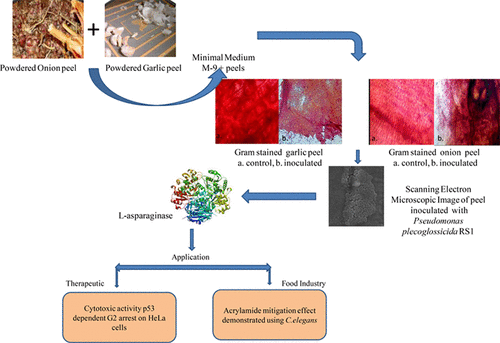Our official English website, www.x-mol.net, welcomes your feedback! (Note: you will need to create a separate account there.)
Agro Waste Utilization for Cost-Effective Production of l-Asparaginase by Pseudomonas plecoglossicida RS1 with Anticancer and Acrylamide Mitigation Potential
ACS Omega ( IF 4.1 ) Pub Date : 2017-11-20 00:00:00 , DOI: 10.1021/acsomega.7b01429 Ganeshan Shakambari 1 , Rai Sameer Kumar 1 , Balasubramaniem Ashokkumar 1 , Perumal Varalakshmi 1
ACS Omega ( IF 4.1 ) Pub Date : 2017-11-20 00:00:00 , DOI: 10.1021/acsomega.7b01429 Ganeshan Shakambari 1 , Rai Sameer Kumar 1 , Balasubramaniem Ashokkumar 1 , Perumal Varalakshmi 1
Affiliation

|
Agricultural wastes such as the peels of onion and garlic were used as a supplement along with l-asparagine for the very first time to produce increased yield of l-asparaginase by Pseudomonas plecoglossicida RS1. Statistical optimization strategies such as response surface methodology were used to generate a medium composition containing extracts of 0.9 (v/v) of garlic peel waste and 0.5% (v/v) onion peel waste along with 0.2% (w/w) l-asparagine, which yielded a twofold increase in the enzyme activity compared to the unsupplemented minimal (M-9) medium. The presence of l-asparagine content in the peel extract was confirmed by high-performance liquid chromatography. Further, l-asparaginase was purified to homogeneity, and identity was confirmed by matrix-assisted laser desorption ionization time-of-flight analysis. The application of the purified l-asparaginase as a therapeutic was studied in HeLa cells which showed a p53-mediated G2 cell cycle arrest. Moreover, the purified l-asparaginase showed effective acrylamide mitigation in vitro, at 6 IU, and its effective degradation was also demonstrated by the effect on chemotactic index of Caenorhabditis elegans and the restoration of the cognitive abilities of C. elegans which was coexposed to acrylamide and l-asparaginase compared to that exposed to acrylamide alone. Thus, l-asparaginase, with multipotent applications, was produced by effective waste utilization for economical commercial production.
中文翻译:

农业废料利用具有成本效益的Pseudomonas plecoglossicida RS1生产具有抗癌和丙烯酰胺缓解潜力的L-天冬酰胺酶
第一次使用农业废料(例如洋葱皮和大蒜皮)与l-天冬酰胺一起作为补品,以通过Pseudomonas plecoglossicida RS1提高l-天冬酰胺酶的产量。统计优化策略,例如响应面分析法被用来产生含0.9的提取物的培养基组合物(V / V)大蒜剥离废物和0.5%的(V / V)洋葱剥离用0.2%(w / w的)废沿升-天冬酰胺,与未补充的基本(M-9)培养基相比,酶活性提高了两倍。通过高效液相色谱法确认果皮提取物中1-天冬酰胺含量的存在。另外,l将天冬酰胺酶纯化至均质,并通过基质辅助激光解吸电离飞行时间分析确认同一性。在显示p53介导的G 2细胞周期停滞的HeLa细胞中研究了纯化的1-天冬酰胺酶作为治疗剂的应用。此外,纯化的1-天冬酰胺酶在6 IU的体外显示出有效的丙烯酰胺缓解效果,并且通过对秀丽隐杆线虫的趋化指数的影响以及与丙烯酰胺共暴露的秀丽隐杆线虫的认知能力的恢复也证明了其有效的降解。与单独暴露于丙烯酰胺中的1-天冬酰胺酶相比。因此,升-天冬酰胺酶具有多方面的用途,是通过有效地利用废物来进行经济的商业生产而生产的。
更新日期:2017-11-20
中文翻译:

农业废料利用具有成本效益的Pseudomonas plecoglossicida RS1生产具有抗癌和丙烯酰胺缓解潜力的L-天冬酰胺酶
第一次使用农业废料(例如洋葱皮和大蒜皮)与l-天冬酰胺一起作为补品,以通过Pseudomonas plecoglossicida RS1提高l-天冬酰胺酶的产量。统计优化策略,例如响应面分析法被用来产生含0.9的提取物的培养基组合物(V / V)大蒜剥离废物和0.5%的(V / V)洋葱剥离用0.2%(w / w的)废沿升-天冬酰胺,与未补充的基本(M-9)培养基相比,酶活性提高了两倍。通过高效液相色谱法确认果皮提取物中1-天冬酰胺含量的存在。另外,l将天冬酰胺酶纯化至均质,并通过基质辅助激光解吸电离飞行时间分析确认同一性。在显示p53介导的G 2细胞周期停滞的HeLa细胞中研究了纯化的1-天冬酰胺酶作为治疗剂的应用。此外,纯化的1-天冬酰胺酶在6 IU的体外显示出有效的丙烯酰胺缓解效果,并且通过对秀丽隐杆线虫的趋化指数的影响以及与丙烯酰胺共暴露的秀丽隐杆线虫的认知能力的恢复也证明了其有效的降解。与单独暴露于丙烯酰胺中的1-天冬酰胺酶相比。因此,升-天冬酰胺酶具有多方面的用途,是通过有效地利用废物来进行经济的商业生产而生产的。



























 京公网安备 11010802027423号
京公网安备 11010802027423号